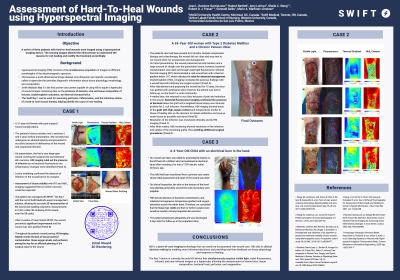Back

Case Series/Study
(CS-117) Assessment of hard-to-heal wounds using hyperspectral imaging

Co-Author(s):
Robert Bartlett, MD, CPE, MAPWCA, FAPWH, UHM, FACEP – Swift Medical; Sheila Wang, MD, PhD – McGill University & Swift Medical; Robert Fraser, MN, RN – Swift Medical; Amy Lorincz, BEng, MS – Swift Medical; Gennadi Saiko, PhD – Swift Medical; Mario Martinez-Jimenez, MD, PhD – Universidad Autonoma de San Luis Potosi
Introduction: Hyperspectral imaging (HSI) assesses perfusion, inflammation, and the infectious status of a wound. Here, we present our experience in using this technology to assess hard-to-heal wounds and how it influenced wound management.
Methods: A series of 4 patients with hard-to-heal wounds were imaged using an HSI device. Photographs with the wound area, its tissue composition calculation, infrared thermograms, bacterial fluorescence, and oxyhemoglobin concentration images were simultaneously obtained for each patient.
Results: Patient 1 is a 69 -year old with a venous ulcer that was skin grafted and underwent epidermiolysis. HSI demonstrated significant bacterial contamination below the grafts. However, HSI imaging demonstrated adequate healing potential, so IV antibiotics were initiated. HSI monitoring showed resolution of the infection and uptake of the grafts, avoiding additional surgical procedures. Patient 2 is a 4-year old that had an electrical burn on the hand. Despite presenting blackened tissue, HSI images showed adequate tissue viability, which allowed us to monitor the progression of the burns. No subsequent surgical interventions were performed as HSI demonstrated an adequate repair.
Discussion: Hyperspectral imaging is a non-contact, non-invasive, point-of-care imaging modality that allows the physiological assessment of wounds; thus, helping uncovering features invisible to clinical inspection alone that can be used to enhance clinical decision-making.
While only 2 patient examples were included in the Results above (due to word limits), we will describe 5 strong cases to demonstrate the impact of HSI on patients aged 4 to 69. Each case will detail how HSI enabled insights to prevent unnecessary procedures or appropriately escalate care to avoid future complications.
Trademarked Items:
References: Ramirez-GarciaLuna JL, Bartlett R, Arriaga-Caballero JE, Fraser RDJ, Saiko G. Infrared Thermography in Wound Care, Surgery, and Sports Medicine: A Review. Frontiers in Physiology (2022) [cited 2022 Mar 12];13. Available from: https://www.frontiersin.org/article/10.3389/fphys.2022.838528
Oropallo AR, Andersen C, Abdo R, Hurlow J, Kelso M, Melin M, et al. Guidelines for Point-of-Care Fluorescence Imaging for Detection of Wound Bacterial Burden Based on Delphi Consensus. Diagnostics (Basel). 2021 Jul 6;11(7):1219.
Saiko, G., Lombardi, P., Au, Y., Queen, D., Armstrong, D., and Harding, K. (2020). Hyperspectral imaging in wound care: A systematic review. International Wound Journal 17, 1840–1856. doi: 10.1111/iwj.13474.
Methods: A series of 4 patients with hard-to-heal wounds were imaged using an HSI device. Photographs with the wound area, its tissue composition calculation, infrared thermograms, bacterial fluorescence, and oxyhemoglobin concentration images were simultaneously obtained for each patient.
Results: Patient 1 is a 69 -year old with a venous ulcer that was skin grafted and underwent epidermiolysis. HSI demonstrated significant bacterial contamination below the grafts. However, HSI imaging demonstrated adequate healing potential, so IV antibiotics were initiated. HSI monitoring showed resolution of the infection and uptake of the grafts, avoiding additional surgical procedures. Patient 2 is a 4-year old that had an electrical burn on the hand. Despite presenting blackened tissue, HSI images showed adequate tissue viability, which allowed us to monitor the progression of the burns. No subsequent surgical interventions were performed as HSI demonstrated an adequate repair.
Discussion: Hyperspectral imaging is a non-contact, non-invasive, point-of-care imaging modality that allows the physiological assessment of wounds; thus, helping uncovering features invisible to clinical inspection alone that can be used to enhance clinical decision-making.
While only 2 patient examples were included in the Results above (due to word limits), we will describe 5 strong cases to demonstrate the impact of HSI on patients aged 4 to 69. Each case will detail how HSI enabled insights to prevent unnecessary procedures or appropriately escalate care to avoid future complications.
Trademarked Items:
References: Ramirez-GarciaLuna JL, Bartlett R, Arriaga-Caballero JE, Fraser RDJ, Saiko G. Infrared Thermography in Wound Care, Surgery, and Sports Medicine: A Review. Frontiers in Physiology (2022) [cited 2022 Mar 12];13. Available from: https://www.frontiersin.org/article/10.3389/fphys.2022.838528
Oropallo AR, Andersen C, Abdo R, Hurlow J, Kelso M, Melin M, et al. Guidelines for Point-of-Care Fluorescence Imaging for Detection of Wound Bacterial Burden Based on Delphi Consensus. Diagnostics (Basel). 2021 Jul 6;11(7):1219.
Saiko, G., Lombardi, P., Au, Y., Queen, D., Armstrong, D., and Harding, K. (2020). Hyperspectral imaging in wound care: A systematic review. International Wound Journal 17, 1840–1856. doi: 10.1111/iwj.13474.

.png)